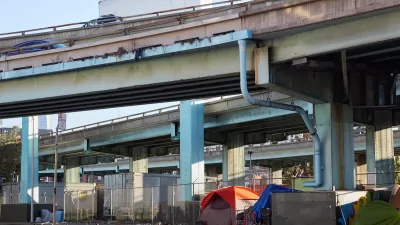While the numbers of unhoused people in other major U.S. cities grow, Houston has managed to effectively end veteran homelessness and house more than 26,000 people since implementing a ‘Housing First’ approach a decade ago.

What is driving Houston’s unparalleled success among big U.S. cities at reducing the number of people experiencing homelessness? As Danielle McLean explains for Smart Cities Dive, “The greater Houston area saw a 53% decrease in its homeless population between 2011 and 2020. During that time, the homeless population in the city and county of Los Angeles grew by 84%, New York City by 52%, and Dallas by 26%.”
McLean adds that “Since 2012, the Houston model has housed over 26,000 people, with 90% of them remaining housed for two or more years, according to Eichenbaum.” By 2015, the city ‘effectively ended’ homelessness among military veterans.
According to McLean, “Houston worked with surrounding county governments, various community stakeholders and nonprofit service providers to develop a model that, despite operating with a small budget, has decreased the area’s homeless population by roughly 63% since 2011, according to a recent city report.”
Houston’s success is attributed to three main factors:
- Housing First: “The city employs a housing-first model that prioritizes providing permanent housing to people experiencing homelessness as quickly as possible with no barriers to entry. The city then provides wraparound support services to ensure they remain housed.”
- A regional continuum of care that puts all organizations and agencies providing services to unhoused people under one umbrella.
- Data-driven decisionmaking that relies on proven data to allocate resources and decide on what projects and initiatives to support.
“But, according to Ann Oliva, CEO of the National Alliance to End Homelessness, success in other cities will depend on communitywide buy-in.” In Houston, widespread support from local officials and stakeholders have been an important aspect of the city’s success.
FULL STORY: How Houston’s homeless strategy became a model for other U.S. cities

Alabama: Trump Terminates Settlements for Black Communities Harmed By Raw Sewage
Trump deemed the landmark civil rights agreement “illegal DEI and environmental justice policy.”

Planetizen Federal Action Tracker
A weekly monitor of how Trump’s orders and actions are impacting planners and planning in America.

The 120 Year Old Tiny Home Villages That Sheltered San Francisco’s Earthquake Refugees
More than a century ago, San Francisco mobilized to house thousands of residents displaced by the 1906 earthquake. Could their strategy offer a model for the present?

In Both Crashes and Crime, Public Transportation is Far Safer than Driving
Contrary to popular assumptions, public transportation has far lower crash and crime rates than automobile travel. For safer communities, improve and encourage transit travel.

Report: Zoning Reforms Should Complement Nashville’s Ambitious Transit Plan
Without reform, restrictive zoning codes will limit the impact of the city’s planned transit expansion and could exclude some of the residents who depend on transit the most.

Judge Orders Release of Frozen IRA, IIJA Funding
The decision is a victory for environmental groups who charged that freezing funds for critical infrastructure and disaster response programs caused “real and irreparable harm” to communities.
Urban Design for Planners 1: Software Tools
This six-course series explores essential urban design concepts using open source software and equips planners with the tools they need to participate fully in the urban design process.
Planning for Universal Design
Learn the tools for implementing Universal Design in planning regulations.
Clanton & Associates, Inc.
Jessamine County Fiscal Court
Institute for Housing and Urban Development Studies (IHS)
City of Grandview
Harvard GSD Executive Education
Toledo-Lucas County Plan Commissions
Salt Lake City
NYU Wagner Graduate School of Public Service





























